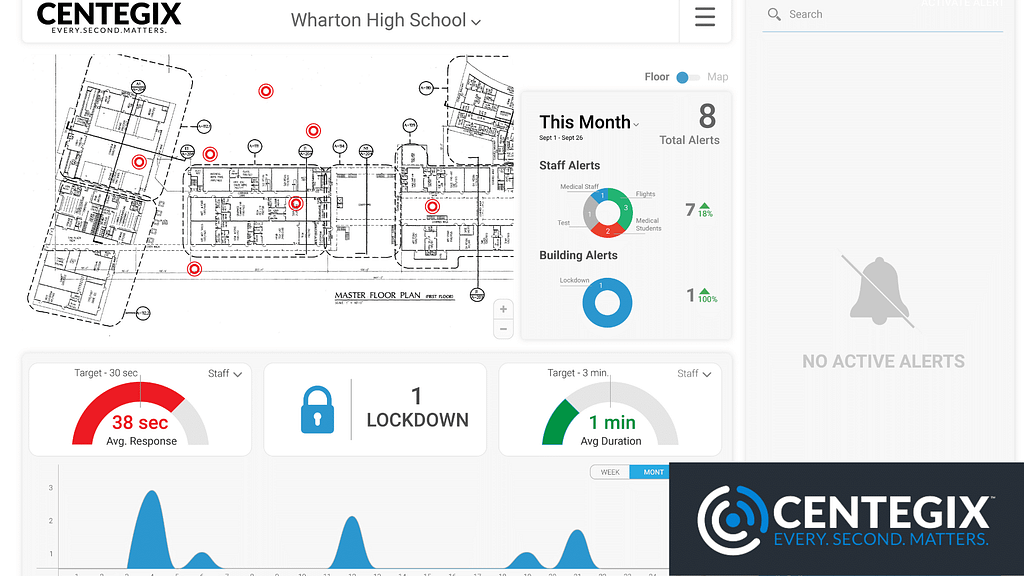Room level mapping refers to a process that identifies potential safety hazards in a workspace. The process involves analyzing the layout and design of a space to determine where potential risks exist and how to mitigate them. Room level mapping protects hospital employees and customers by proactively anticipating where and how accidents or injuries could occur and working to prevent them. Thorough room mapping requires data. A healthcare safety system that accurately collects and reports data about injuries, accidents, and workplace violence in healthcare enables decision-makers to mitigate workspace risks effectively. Hospitals seeking maximum benefit from the room mapping process must seek healthcare safety solutions designed to capture the data needed to inform these critical decisions.
What Does Room Level Mapping Entail?
When constructing a room map, an analyst inspects the physical environment of a room, building, or campus to determine where potential risks exist. This inspection includes an analysis of the physical environment:
- lighting
- ventilation
- flooring
- workspace layout
- furniture and arrangement of furniture
Room mapping also takes into account the presence of hazardous materials or equipment. The primary concern is safety: how might each of these elements cause injuries or accidents? By analyzing these elements in advance, hospitals protect staff members, patients, and consumers from preventable accidents and injuries. By constructing a room map, hospitals, and business owners can reduce risk and the often burdensome costs associated with workplace injuries and accidents.
How Room Mapping Helps Prevent Workplace Violence in Healthcare
In addition to providing information that can mitigate physical injury, room mapping contributes valuable data to the threat assessment process. Unfortunately, workplace violence in healthcare is becoming increasingly common. Given this reality, healthcare administrators must seek healthcare safety solutions that mitigate the risks associated with potential violence committed by patients and other consumers.
A threat assessment is a behavior-based inquiry process that helps organizations respond to a threat of targeted violence. Threat assessments also aim to identify individuals moving toward an intentionally harmful event. This multi-disciplinary process identifies, assesses, and works to mitigate concerns of deliberate violence. The process resembles room mapping in that it is a preemptive effort to prevent workplace violence in healthcare.
Practical workplace violence prevention efforts start at the top. Healthcare industry leaders must recognize that workplace violence in healthcare is a potential problem and embrace the attitude that the organization can take proactive actions to prevent it. This mindset will then flow down to the staff.
Data is Key to Proactive Prevention

Workplace violence in healthcare
Recognizing potential risks of physical injury and workplace violence in healthcare requires data. To mitigate risks, decision-makers need to see where and when incidents occur. Just as room mapping provides data about what obstacles may obstruct a nurse’s path to a patient’s bed, effective healthcare safety solutions provide data about factors contributing to workplace violence. A healthcare safety plan that includes an effective way to gather data provides administrators with the insight required to allocate resources in a manner most likely to keep caregivers safe, healthy, and satisfied with their workplace.
Data makes strategic resource allocation possible. Managers must possess detailed knowledge of the daily inner workings of a clinic or hospital floor if they hope to understand why an incident of workplace violence occurs. A healthcare safety solution provides concrete data that can help administrators identify the factors that may set the scene for violence. Hospital leaders can then strategically direct resources toward these factors, including performing additional analysis or seeking the support of a multi-disciplinary threat assessment team. Quality data makes this advanced level of risk mitigation possible.
Best Practices for Implementing Healthcare Safety Solutions
The first step in performing a high-quality risk or threat assessment is to assemble a team. The threat assessment team should be carefully curated and comprised of a cross-section of health and safety professionals and other subject matter experts who have hands-on work experience. Threat assessment teams may include law enforcement or other security personnel. This team follows a series of steps:
- Identify “zones.” The team divides the space into sections that can be examined closely and identifies the zones that require further attention.
- Analyze the layout. Team members study the current layout of a space and identify specific elements that require improvement in terms of security and safety.
- Develop a plan. Outline the changes required and determine exactly how to execute the necessary alterations.
- Implement the plan.
- Monitor performance. Constantly observe the workspace and analyze if changes are effective and whether further improvements are necessary.
Implementing brand-new safety systems is a heavy lift for any organization. These changes fall most heavily on employees who must adjust their habits and work routines. So identifying the implications of any new technology is critical. Safety technology industry experts point out that it’s not always easy being in charge of implementing change. But to make things go as smoothly as possible when implementing healthcare safety solutions, managers must ask themselves: what benefits will accrue to the organization due to these changes? How will employees react? The bottom line: a new healthcare safety solution must be effective and the right fit for your employees.
Safety Depends Upon Monitoring

Workplace violence in healthcare
Monitoring and data analysis are critical to ensuring that a healthcare safety solution functions as intended. Without it, administrators are left operating in the dark with no clear window into information that could help identify problems proactively. Ideal safety monitoring devices feature uninterrupted connectivity and provide a constant stream of valuable information. By applying data analytics—either using an in-house team or outsourcing—leaders can search for patterns and identify unanticipated problems. According to security experts, collecting and reporting on vital data is critical to take an organization’s safety program to the next level.
CENTEGIX CrisisAlert is a healthcare safety solution that gathers data and makes it available for informing resource allocation decisions. The CrisisAlert Administrator dashboard allows administrators to:
- manage users
- assign badges
- define alert types
- configure responder groups
- initiate badge training sessions
- configure IP integrations
- access the analytics dashboard
The data analytics dashboard gives administrators and managers access to information in real-time, so they can monitor their employees’ safety and intervene in potentially dangerous situations before they occur. CrisisAlert allows administrators to easily integrate the critical step of monitoring into their safety system implementation.
CrisisAlert: Safety Through Data
Many crises that occur in healthcare settings are exacerbated by communication lapses. CENTEGIX CrisisAlert runs on a dedicated IoT network, thereby eliminating these lapses. In facilities that use CrisisAlert, caregivers wear mobile badges with which they can initiate alerts during emergencies. In response, the CrisisAlert system instantly transmits data to hubs located throughout the floor or campus and to first responders. The system also features desktop takeovers so that everyone present has the same accurate information about incidents of all kinds, including workplace violence in healthcare.
When a facility is protected by CrisisAlert, its employees receive updates in real-time that allow them the information they need to enact safety protocols or threat assessment tools. The CENTEGIX CrisisAlert healthcare safety solution can be integrated into any healthcare setting with minimal disruption to infrastructure and serves as a valuable tool for keeping staff members safe and providing administrators with the data they need to protect their workforce and prevent workplace violence in healthcare.
CENTEGIX is the leader in incident response solutions. Our CrisisAlert platform is the fastest and easiest way for staff to call for help in any emergency, from the everyday to the extreme. CENTEGIX creates safer spaces by innovating technology to empower and protect people, and leaders nationwide trust our safety solutions to provide peace of mind. To learn more about CENTEGIX, visit www.centegix.com.

